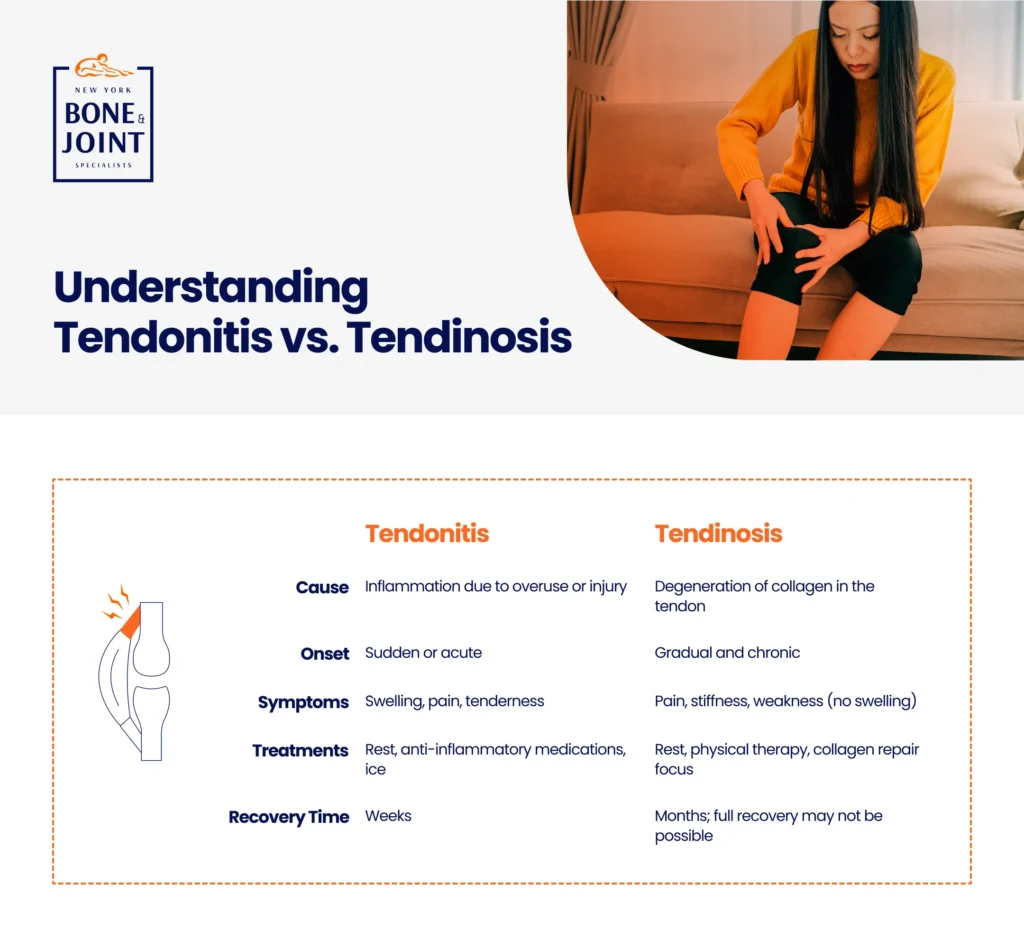Not all tendon pain is tendonitis — it could also be tendinosis. Here’s how to tell these conditions apart.
Tendon injuries are quite common in the U.S., and it’s easy to see why: Tendons are strong yet flexible bands of tissue connecting muscles to bones, enabling joint movement. Whether you’re playing sports or typing at a desk, tendons endure constant use, making them especially vulnerable to overuse and injury. In fact, one study estimates that about half of the 33 million musculoskeletal injuries reported each year involve tendon and ligament ailments.
You may think any painful tendon condition is tendonitis — and most could be — but that’s not always the case. Tendonitis is just one form of tendinopathy, a broad term for tendon diseases that also includes tendinosis. While both conditions have a few similar characteristics, each has distinctive causes and symptoms. So, let’s compare tendonitis vs. tendinosis to help you better understand the potential cause of your pain and seek the right treatment.

What is tendonitis?
Tendonitis develops when the tendon becomes inflamed from an injury, overuse, or extreme strain. Although athletes are most at risk, anyone performing repetitive tasks, such as typing or lifting, can develop tendonitis.
Tendonitis frequently affects the elbow, knee, shoulder, and Achilles tendon, which you use when flexing your foot and ankle. Tendonitis can also impact the wrists and fingers.
Symptoms. A dull ache, swelling, and a feeling of tightness in the joint. The pain may worsen when you move, and the tendon may be tender to the touch.
Treatment. Rest is key to alleviating tendonitis. Avoid activities that aggravate the tendon, and consider over-the-counter anti-inflammatory medications like Advil or Aleve. Cortisone injections may also help reduce inflammation and pain. Cold compresses can relieve swelling, while heat therapy can loosen stiff tendons. Physical therapy to improve range of motion is often recommended, and in severe cases, arthroscopic surgery may be necessary.
Recovery. With conservative treatments, tendonitis typically improves within a few weeks. Recovery may take longer if surgery is required.
What is tendinosis?
Tendinosis is a progressive, degenerative condition caused by the breakdown of collagen fibers in the tendon. Over time, this weakens the tissue, and as other cells attempt to repair the damage, the tendon becomes stiffer and heavier. Tendinosis can occur in any tendon but most commonly affects the knee, heel, foot, elbow, shoulder, and thumb.
Like tendonitis, tendinosis can result from repetitive strain injuries. Another risk factor is a prior injury that doesn’t fully heal. Chronic inflammation of the tendon can also lead to tendinosis, and certain medications such as antibiotics, corticosteroids, and statins can cause the breakdown of collagen. Since it is a degenerative condition, tendinosis may also be related to osteoarthritis.
Symptoms. Common symptoms include chronic pain lasting more than three months, a burning sensation with movement, stiffness, limited range of motion, and weakness in the tendon. Unlike tendonitis, tendinosis typically does not cause swelling.
Treatment. To slow the progression of tendinosis and rebuild collagen, your healthcare provider will recommend resting and limiting any activities that stress the tendon. For pain relief, you can take acetaminophen or topical pain relievers, but corticosteroids and non-steroidal anti-inflammatories are not recommended. Physical therapy and deep friction massage can improve circulation and prevent muscle atrophy. Platelet-rich plasma injections may also help with healing. Surgery is reserved for severe cases where abnormal tissue needs removal.
Recovery. While full recovery may not be possible due to permanent damage, treatment can restore near-normal function. However, the tendon may remain prone to future injuries, requiring ongoing monitoring.
Because tendonitis and tendinosis have several overlapping symptoms and are often mistaken for each other, your doctor will need to make an accurate diagnosis to find the proper treatment path. An ultrasound can typically reveal the inflammation of tendonitis and the degenerative changes associated with tendinosis.
Take care of your tendons
Your tendons are an important part of your body — after all, they help you move and do all the things you do every day! As a leading sports medicine center, the doctors and staff at New York Bone & Joint Specialists will diagnose and treat your tendon condition and get you moving again. Contact us today for a consultation.




